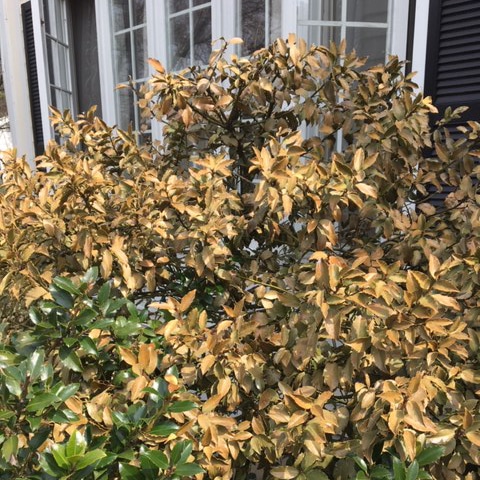
Winter weather this past season had its ups and downs and now many plants are showing signs of leaf only or leaf and stem desiccation, also called Winter Burn. Broadleaf evergreens seem to be the one types affected the most. I have seen damage on needle evergreens as well. Besides winter burn we have seen damage to foliage because of root and stems freezing and thawing and lastly snow reflection on the plant.
How winter burn or winter kill is caused can vary from season to season. During the warm days from January through March the plants start waking up and are moving fluids through the plant. Then the temperature drops at night. This is a huge shock for the plant. Look at the temperature swings we had this past year. (Diagram below from AccuWeather). Also the roots are affected by this huge temperature swings. The killer is actually the snow. When we get even a little snowfall, the sun reflects off of that and warms up the stems even more during the day.
I have seen many plants where the west side is burnt, or the tops are burnt. This is definitely because of the snow reflection. On some plants the foliage is brown and crispy. Those stems that are flexible and have green coloration are probably alive, even though the foliage is dead. If that is the case be patient and wait till end of May and see what leaves come back and replace the damage. If the stems are brittle and break when bent, then they are dead.
Those stems should be pruned back to the green part of the plant and wait until new growth comes back this spring to replace some of it. If the entire plant or more than 50% is dead then you may want to remove the plant and install a different plant that can take the conditions of winter in that location.
I recommend fertilizing your plants with either Espoma Holly Tone or Neptune’s Harvest. This product seems to help plants with stress. Patience is what you need to have as well. Damage that happened can’t be fixed. This fall you may want to put more effort into protecting your plant in the winter which can help reduce some of the winter damage to plants. We have a seminar in the fall called Winterizing Your Plants. I recommend you come in and see one of our Horticultural Experts in the fall and they can assist you with what preventive measures you can take so the damage can be minimized.







